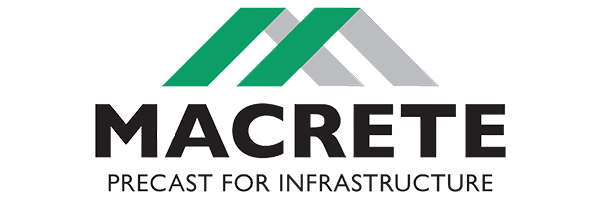BRP – Treated Water Project – Birmingham Resilience Project (2020)
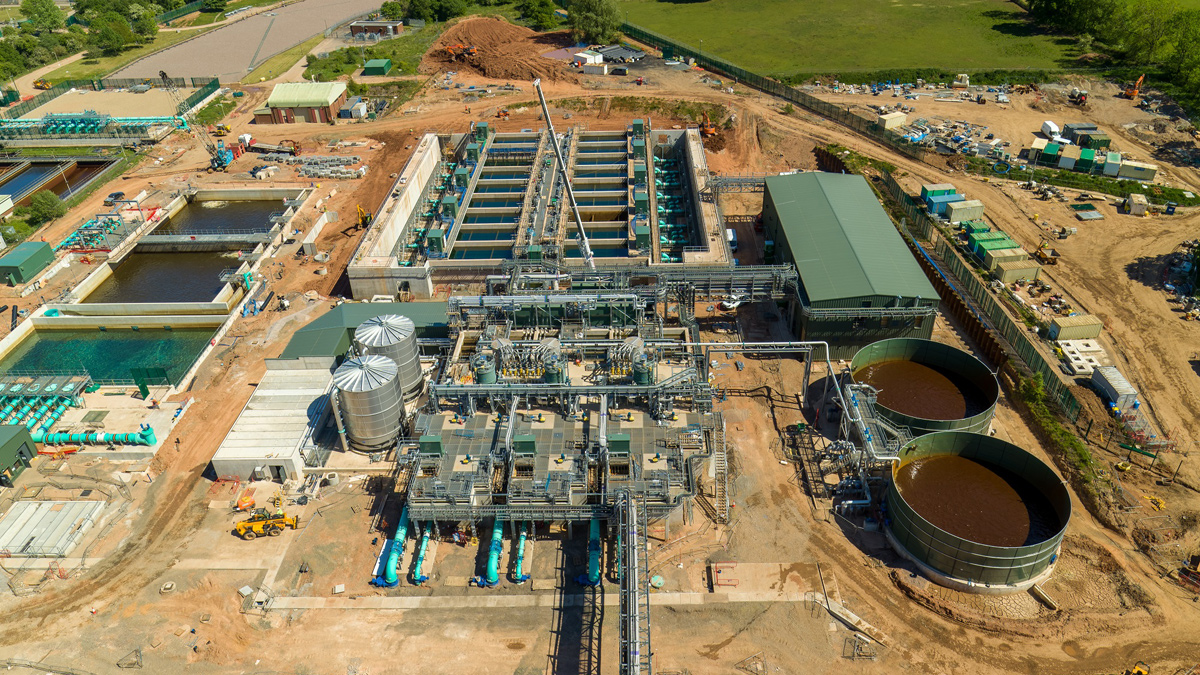
New treatment stream undergoing commissioning - Courtesy of Severn Trent
Raw water has been collected in reservoirs in the Elan Valley in Wales and transferred 118km under gravity through an aqueduct to the water treatment works (WTW) in Birmingham for treatment and distribution to the city’s residents and industries since the beginning of the 20th century. The original infrastructure was constructed over 100 years ago, and whilst the WTW has seen significant development over the years to improve water quality, development work on the aqueduct has been much less extensive. The aqueduct is regularly inspected, surveyed and minor maintenance work has been undertaken.
To safeguard the aqueduct and secure another century of service it is necessary to undertake extension, maintenance and repair work to it, which can only be completed whilst it is out of service. To facilitate this work requires an alternative source of raw water, abstracted from the River Severn, to be delivered to the WTW and treated, to maintain supply whilst work is undertaken on the aqueduct. The river water is pumped to the WTW using an existing pumping station, and a new pumping station with 20km of 1050mm ID rising main provided as part of the Birmingham Resilience Project.
The subject of this article is the upgrades to the WTW to provide raw river water treatment, with the added capability of treatment of Elan Valley water, thereby providing enhanced treatment capability to the existing treatment works in normal operation.
Background
The WTW today comprises two parallel process treatment streams fed from an off-site and an on-site reservoir, both supplied with water from the Elan Valley. The current treatment processes have evolved from the original sand filters and now comprise much more modern treatment processes including, dissolved air floatation (DAF), rapid gravity filters (RGFs), granular activated carbon (GAC) filtration, pH correction. Treated water is disinfected with chlorine. The GAC plant is dedicated to one stream, following the RGFs, and enables blended river water treatment capability but not raw river water treatment capability.
The new WTW stream contract was awarded by Severn Trent to NMC Construction Limited (now Galliford Try) in June 2017. NMC formed a Joint Venture Alliance with Korean company Doosan Enpure Ltd to deliver the project as DNMA. The construction works is valued at around £120m. Completion of the whole Birmingham Resilience Project, including this new treatment stream had an OFWAT deadline set out in the Severn Trent Final Business Plan of 31 March 2020, with penalties amounting to millions of pounds for underperformance and failure to deliver on time.
Severn Trent promoted the Treated Water Project to provide a new treatment process stream (Stream 3) at the WTW capable of treating the current raw water feed from the Elan Valley and raw water from the River Severn. The treatment capacity of the new process stream will be approximately 25% less than the current works maximum throughput and will be supplemented by the water network during an aqueduct outage, to meet demand.
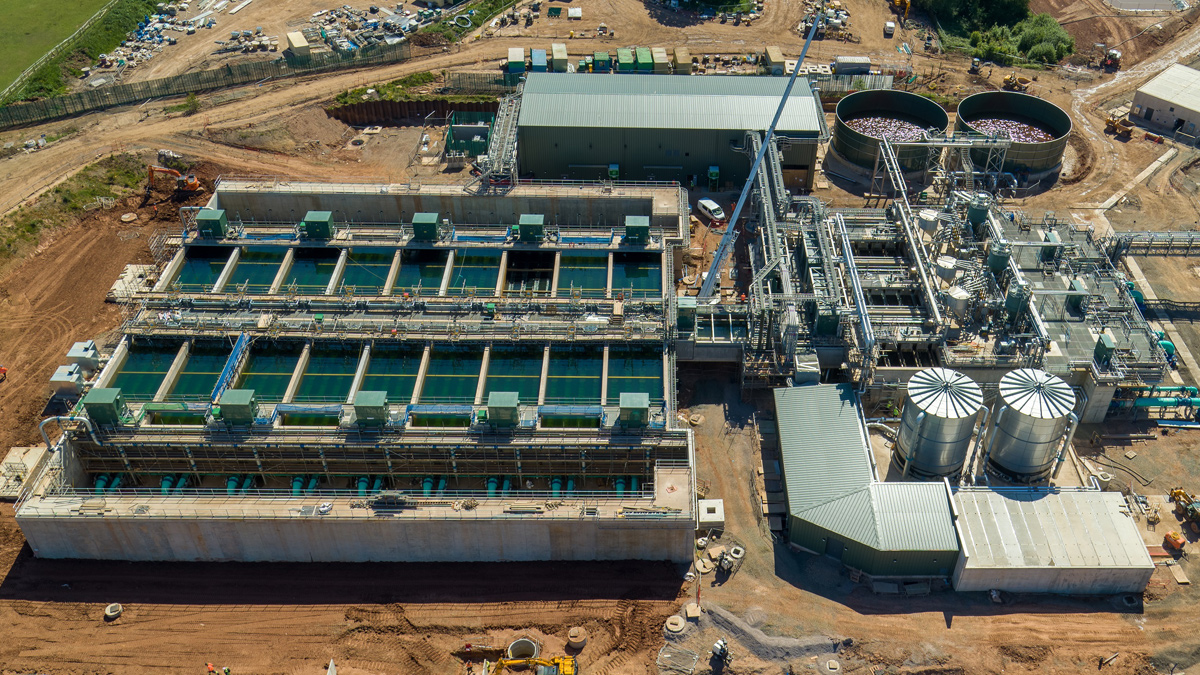
RGFs in operation (left) and completed SBLs (right) – Courtesy of Severn Trent
The new treatment stream processes and their state of progress (May 2020) is explained below.
Powdered activated carbon plant (PAC)
The first stage of raw river water treatment comprises two powdered activated carbon (PAC) installations, dosing PAC into river water as it is conveyed to the treatment works. The PAC plant is a proprietary package system designed, produced, installed by Transvac Systems Ltd and commissioned in October 2019. The delivery mains discharge into the on-site reservoir at the treatment works, which enables settlement of excess PAC prior to entering on site water treatment processes.
Connection of the on-site reservoir to new treatment stream
Raw water delivered under gravity from the aqueduct, or pumped from the river, arrives at the inlet chamber to the existing on-site raw water reservoir which has two draw off towers – north and south. The north tower feeds the existing treatment streams and the south tower has been altered under this project to feed the new treatment stream.
The change of use of the south tower required excavation to the base of the 100-year-old structure, approximately 10m below ground level to allow connection of 3 (No.) 1600mm diameter steel pipes to the existing draw-off pipework. These pipes connect into the 2100mm diameter raw water feed to the new treatment stream. To protect the stability of the tower, and reservoir, during these alterations required extensive ground works support, including secant pile walls which will remain in place after backfilling is complete, to facilitate future excavation work.
The 600m long 2100mm diameter feed pipe from the south tower to the new treatment process and the 3 (No.) 1600mm diameter connections from the south tower were completed, pressure tested and brought into service in October 2019, allowing commissioning of the new treatment stream to commence to programme.
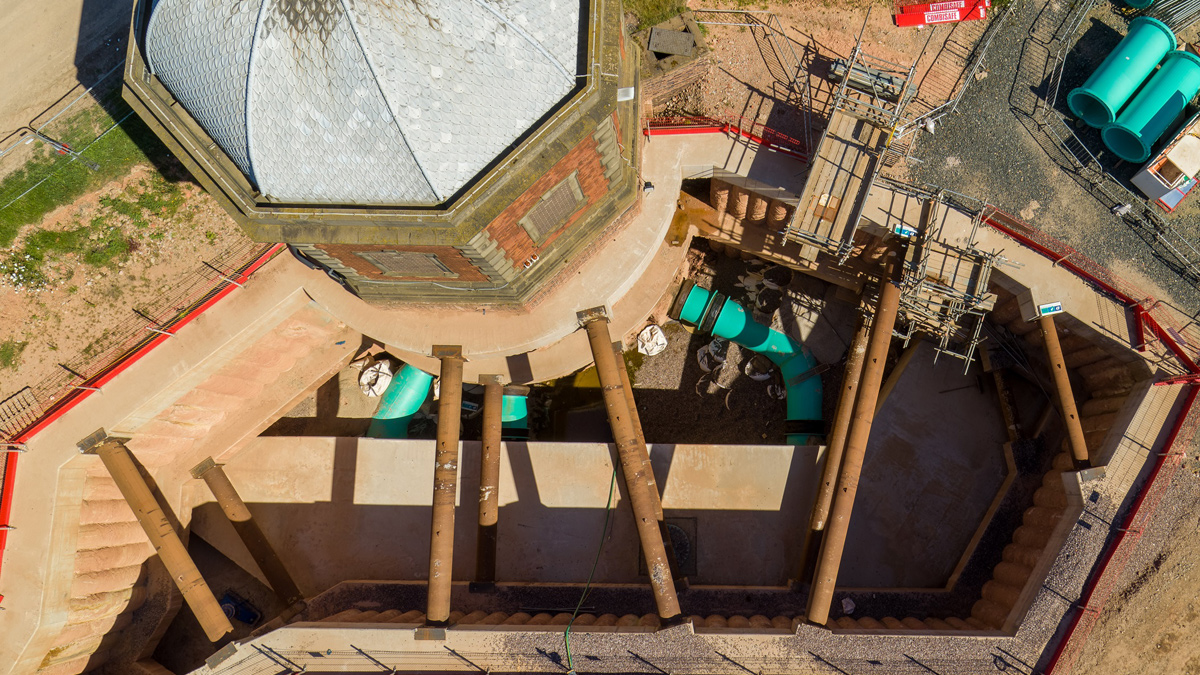
South tower excavation and pipework connections – Courtesy of Severn Trent
Raw water inlet pumping station (RWIPS)
A new raw water inlet pumping station (RWIPS) has been constructed to enable the reservoir to be drawn down to 80% of its full depth (8m) once the reservoir level drops below the gravity delivery threshold of 2m below top water level. This facility ensures security of supply whilst work is undertaken on the aqueduct.
The RWIPS comprises a reinforced concrete dry well sump 12m x 21m x 6m deep, containing 4 (No.) pumps operating on duty/assist/assist/standby basis and capable of delivering up to 312 Mld to treatment on a variable upstream head; which has made the operating philosophy very complex. The RWIPS is installed and ready for commissioning.
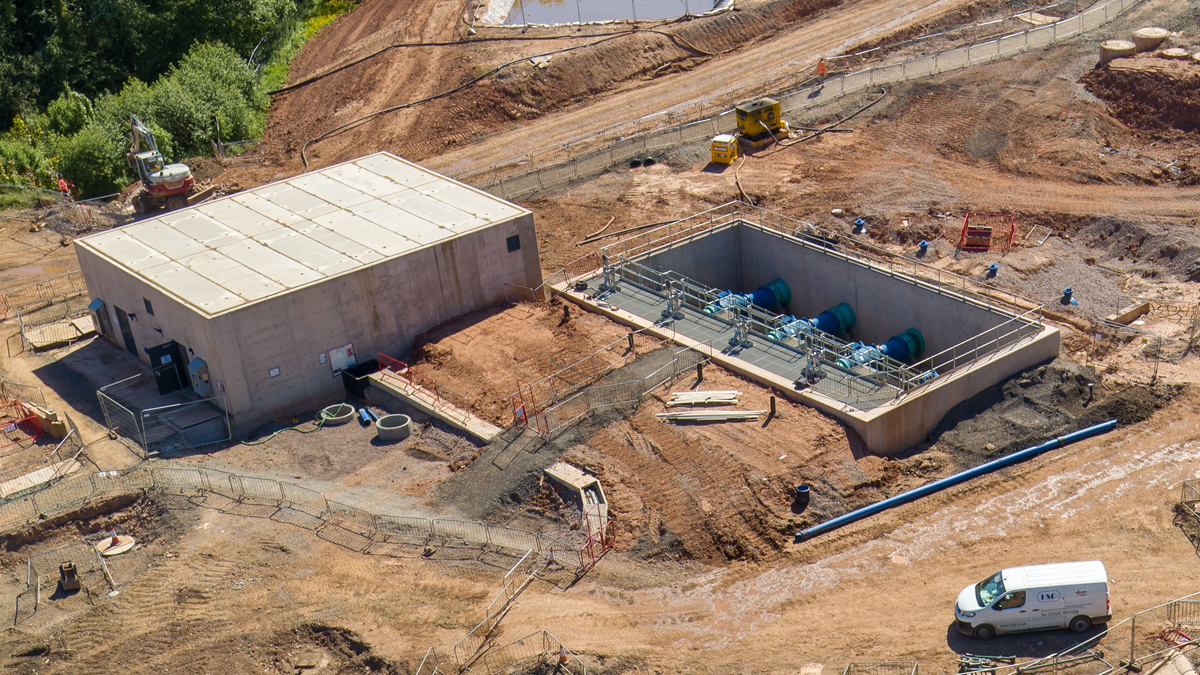
Chemical mixing chamber (left) and raw water inlet PS (RWIPS) (right) – Courtesy of Severn Trent
New treatment processes
Raw water is fed under gravity or by the pumped system from the reservoir directly into the new clarification process.
Clarification: 3 (No.) new Actiflo® AC90 sand ballasted lamella (SBL) process units from Veolia Water Technologies have been installed to provide the most suitable clarification process for treating both river and Elan Valley water. The process selection was based on extensive pilot trials. This is the first installation of SBLs in the Severn Trent Region.
The bespoke in situ reinforced concrete structures were cast in 2018 and have subsequently been fitted out with lamella plates, mixers, sand handling and dosing plant and all the control and management systems necessary for an automated treatment process. With completion of the motor control centres cabling, and supporting infrastructure available, the units were commissioned during February and March 2020.
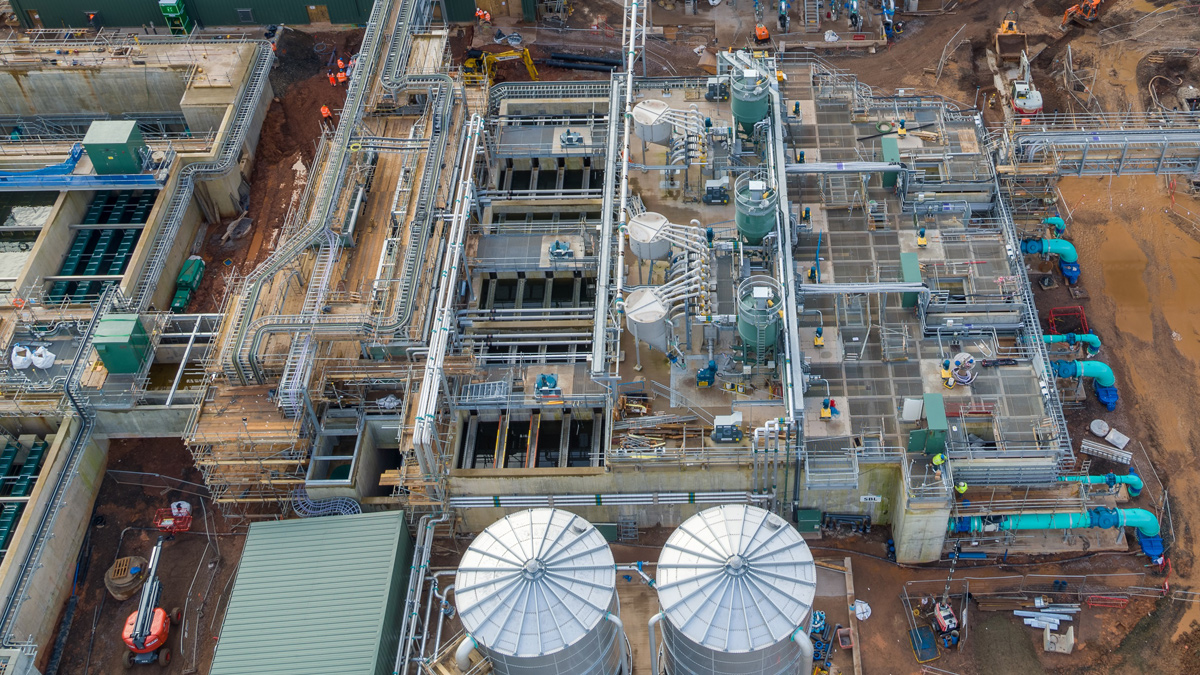
Completed SBL installation in operation – Courtesy of Severn Trent
Commissioning of the SBLs included setting up and operating each unit across the full range of design flows, using Elan Valley water, and running the units at various combinations to confirm process and hydraulic design parameters have been met. The SBLs are performing in line with expectations. River water trials are imminent, though the process is deemed proven through the pilot trials.
Rapid gravity sand filters (RGF): The new 18 (No.) cell rapid gravity filtration unit (RGF) is contained in an in situ reinforced concrete structure of overall dimensions of 38m wide x 66m long x 8.5m deep, which receives flows from the SBLs via a common inlet channel.
The RGF was completed towards the end of 2019 by the placing of media fill and completion of the header pipework installation. RGF commissioning overlapped with SBL commissioning to minimise the overall commissioning programme duration and also took place in February and March 2020.
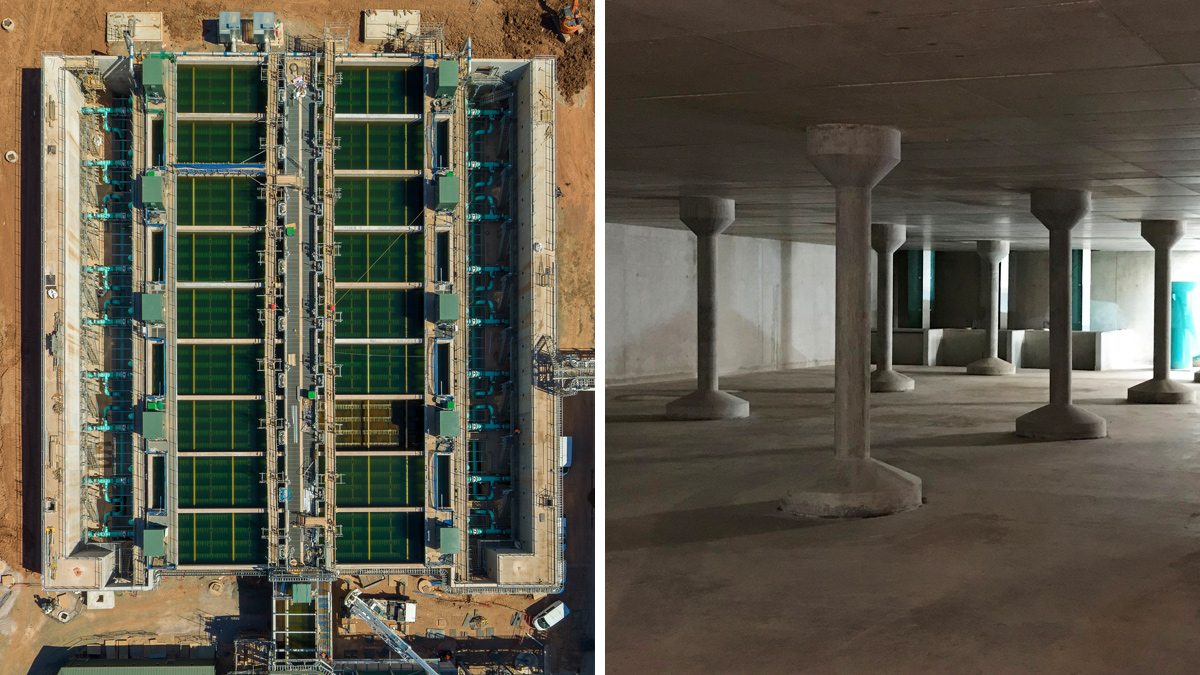
(left) Aerial photo of completed RGFs units in operation and (right) inside clean backwash water tank – Courtesy of Severn Trent
RGF clean and dirty backwash systems: The new RGF process relies on clean and dirty backwash systems to meet treatment requirements. These systems have been sized to also replace the asset expired units servicing the existing 40 (No.) cells RGFs – introducing an additional layer of complexity into commissioning. The clean and dirty backwash systems incorporate tanks of approximately 40m x 40m x 5m deep in situ reinforced concrete structure, built in the footprint of existing abandoned sand filters.
The new clean backwash water tank (CBWT) and pump-sets are split into two compartments to enable maintenance whilst operational. This tank was used to store water for commissioning of the new stream and was brought into service in December 2019.
The dirty backwash water tank (DBWT) receives dirty backwash water from the RGFs and returns settled water to the on-site reservoir using the liquors return pumping station which is contained in a sump integrated into the DBWT. The tank comprises two compartments to enable maintenance whilst operational.
The liquors return pumping station has a dual functionality and can return flows from any treatment stream to the on-site reservoir in the event of a water quality failure of that stream – in this mode it is known as the emergency return pumping station (ERPS). The ERPS formed a critical element of the commissioning strategy as it enabled water used during commissioning to be returned to the reservoir instead of having to be fed into supply. This facility significantly reduced the risk to water quality and supply during the commissioning process.
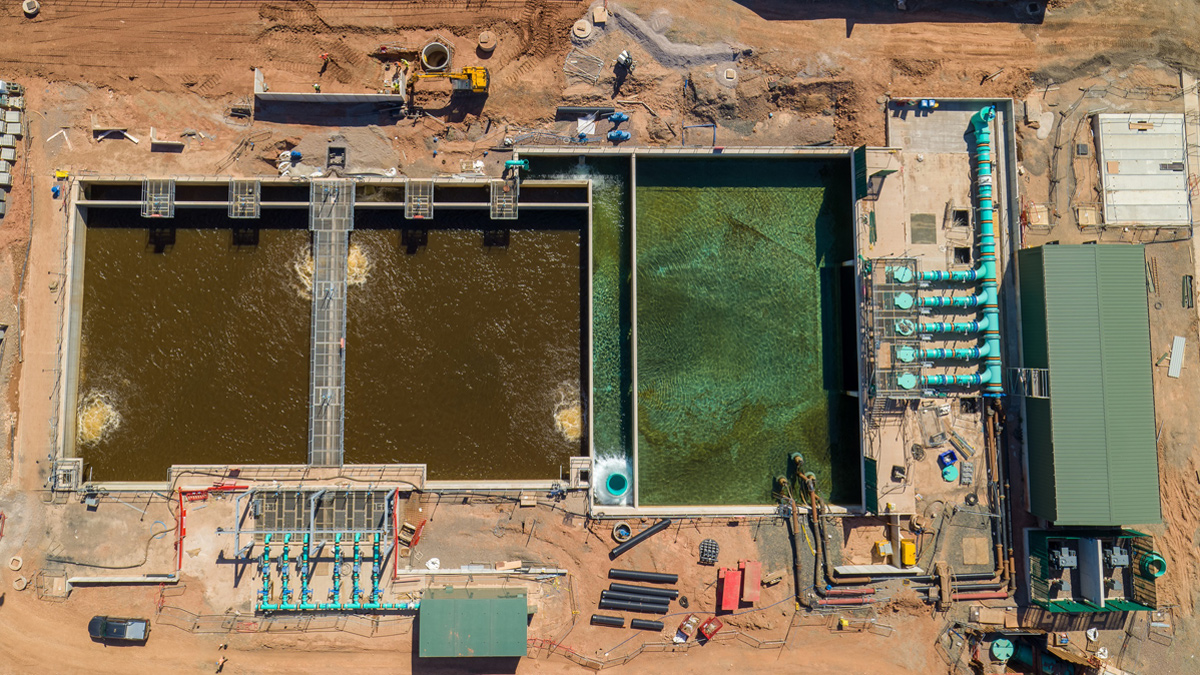
Aerial view of twin compartment dirty backwash tank (left) and liquors/emergency return PS (right) – Courtesy of Severn Trent
Ancillary systems and processes
Chemicals: Various chemicals are used throughout the treatment process, requiring batching, storage, transfer, dosing and mixing facilities; housed in bunds, buildings and buried concrete structures. All these chemical systems were included in the commissioning procedures and brought into service during February and March 2020.
Sludge treatment: A new sludge treatment plant has been constructed which now serves the whole site replacing the previous facilities. The sludge treatment process is based on wash water lamella plant (WWLP) provided by Paques bv, and maximises water recovery for treatment, whilst minimising sludge discharged to sewer. Centrifuges provide additional treatment when the plant is treating river water, to produce an inert sludge cake for removal off site. The sludge treatment plant is now operational and was required to be in service to enable commissioning of the water treatment processes.
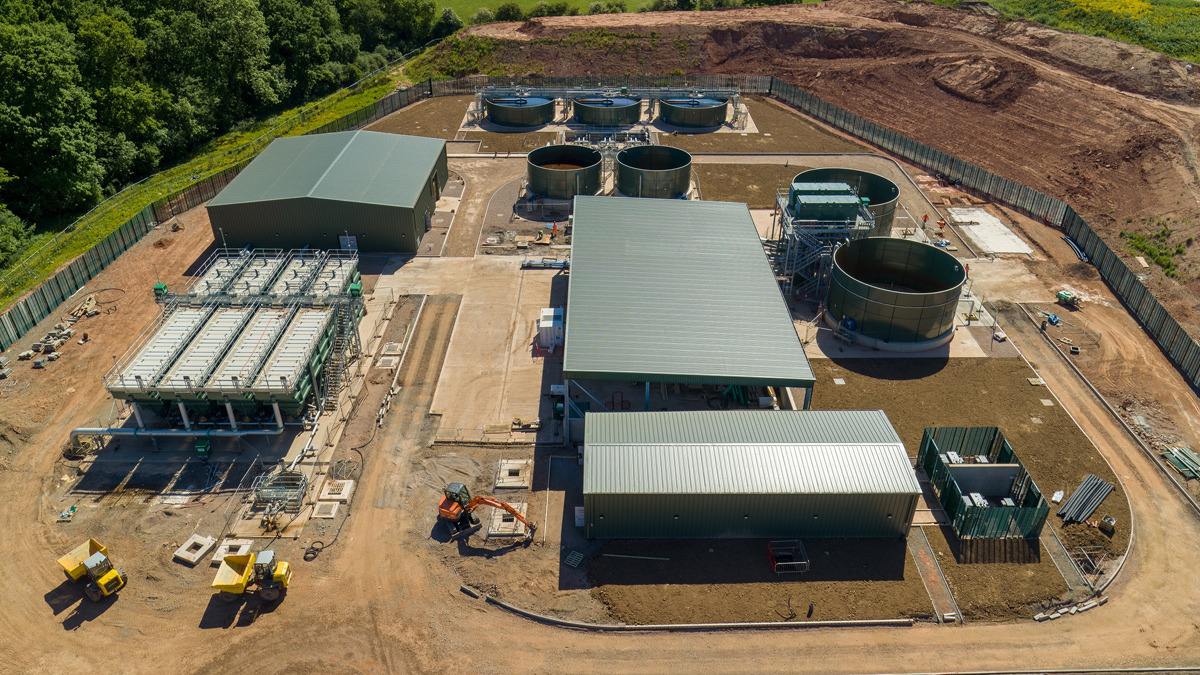
Sludge plant area – Courtesy of Severn Trent
Infrastructure work
In addition to the treatment units the scheme includes 11,000m of pipework from 80mm ID to 2100mm ID, ancillary pumping stations HV cabling, LV cabling, HV substations, demolition of an existing building, new roads, new drainage systems, security systems and fencing. Every element of these works required for commissioning has been installed; the less critical elements and finishing works will follow, with expected completion by December 2020.
BRP Treated Water Projects: Supply chain key participants
- Delivery contractor: DNMA (Doosan Enpure Ltd/nmcn (now Galliford Try) JV
- Civil/structural design: GHD
- Technical documentation: 3rd Light Media
- Shoring/temporary works: National Trench Safety UK
- FRC: STAM Construction Ltd
- Precast concrete columns – CBWT: Marshalls CPM
- Precast concrete – Trench & covers: FP McCann
- Precast concrete – Wall panels: ACP Concrete
- Buildings: Structural Steelwork Ltd
- Mechanical installation (RGF, SBL and RWPS mechanical build and South Tower works): Franklyn Yates Engineering Ltd
- Pipes & fittings: Freeflow Pipesystems Ltd
- Pipes & fittings: Radius Systems
- Pipes & fittings: Pipesource UK
- Access covers & walkways: Technocover
- Access covers & walkways: Deritend
- Access covers & walkways: Steelway
- Filter media: Western Carbons Ltd
- Transformers & HV switchgear: Schneider Electric
- Actiflo® sand ballasted lamella: Veolia Water Technologies
- Powdered activated carbon plants: Transvac Systems Ltd
- Wash water lamella plant: Paques bv
- Centrifugal pumps: Bedford Pumps
- Centrifugal pumps: Hidrostal Pumps
- Centrifugal pumps: Sulzer Pumps Wastewater Ltd
- Pump booster sets: KGN Pillinger
- Ventilation: Project 77 Environmental Ltd
- Valves & penstocks: Glenfield Invicta
- Valves & penstocks: Cotswold Valves Ltd
- Tanks: Balmoral Tanks
- Tanks: Forbes Technologies Ltd
- Tanks: SPEL Products
- Chemical dosing: IIES (Northern) Ltd
- Chemical dosing tanks: Richard Alan Engineering
- Protectaflex dual contained hose for chemical treatment dosing plant: FT Water Treatment
- Lime dosing progressive cavity pumps (BRP): SEEPEX UK Ltd
- Lime dosing items: Sulzer Pumps Wastewater Ltd
- Lime dosing items: Siemens
- Kiosks: Morgan Marine
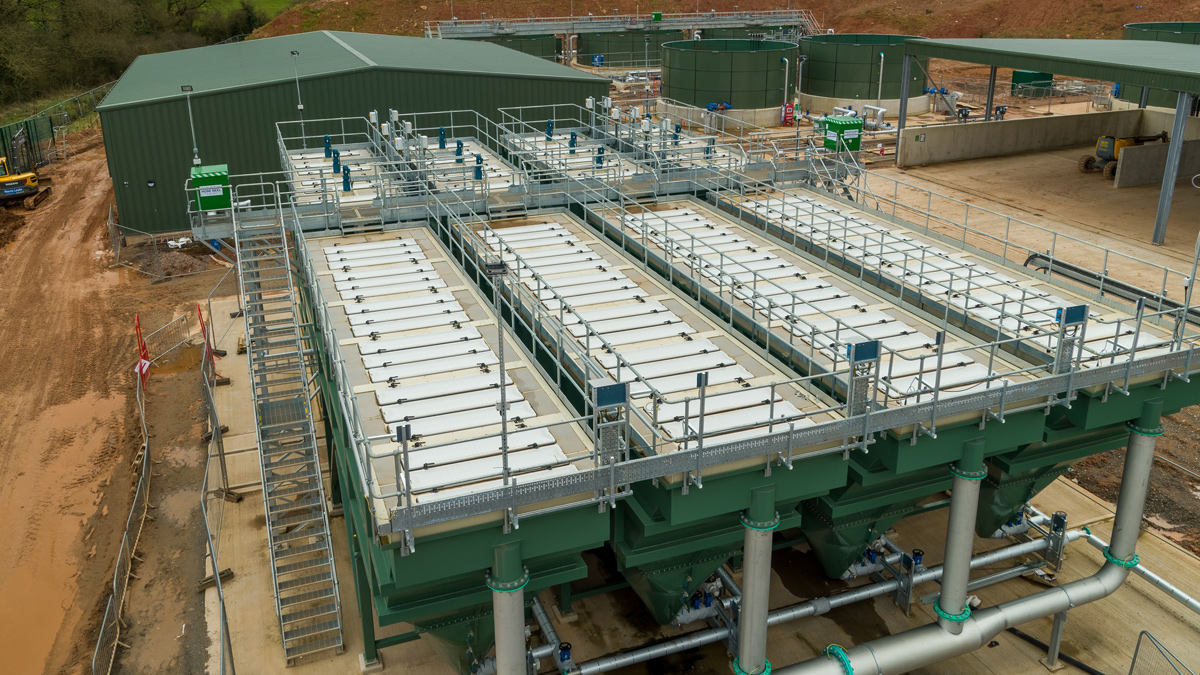
Wash water lamella for sludge treatment from Paques bv – Courtesy of Severn Trent
Completion/conclusion
The Birmingham Resilience Project (BRP) is Severn Trent’s largest capital investment on a single programme of work since privatisation. The critical Outcome Delivery Incentives (ODIs) have been delivered by the deadline of 31/03/2020, as required by OFWAT, in accordance with Severn Trent’s AMP6 Business Plan commitments.
The treated water element of BRP is arguably the most complex construction element of the programme, with multiple process functions and construction within one of the UK’s largest operational water treatment works – which remained unaffected throughout. The lead in time for the project was longer than other elements of BRP due to the complexity and commercial arrangements, leaving a compressed period for construction.
It is testament to the commitment and teamwork of all of the individuals, from all of the parties involved, that a project of this scale and complexity has been delivered within the timescales available, under the relentless pressure of significant penalties for failure to deliver on time.
The new WTW stream is proving to perform beyond expectations, it has been delivered on time to a standard befitting the legacy of Severn Trent’s BRP programme, securing the water supply for Birmingham’s residents and industries now and for the foreseeable future.













